OKC Thunder 2022 Draft Day Guide: Top Prospects, Financials, Areas of Improvement, and More Going into Draft Night
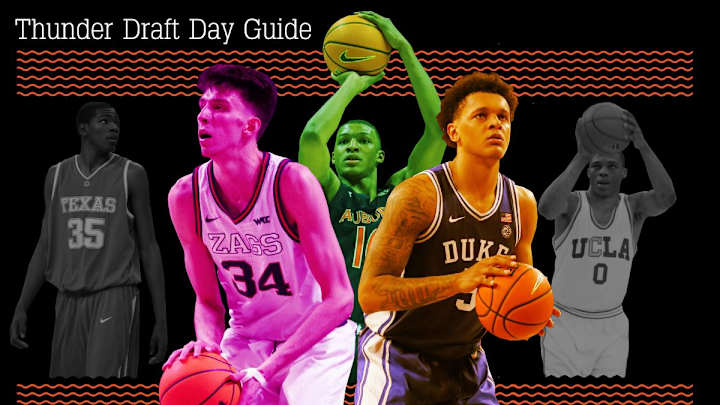
The Oklahoma City Thunder enter tonight’s NBA Draft with a historic haul on their hands. Following last month’s lottery, which saw the organization claim their highest draw in franchise history at No. 2 – they’ll be looking to cash in on a cornerstone piece in Sam Presti’s ongoing rebuild. To pair with their ping-pong palooza, the Los Angeles Clippers’ play-in plummet notched the Thunder a second lottery selection at No. 12. That makes them the lone team with two lottery selections headed into the night.
Here’s a full guide on the Thunder’s picks, their areas of improvement, financials, and top prospects leading up to the podium (6:30 p.m. CST, ESPN):
Contents
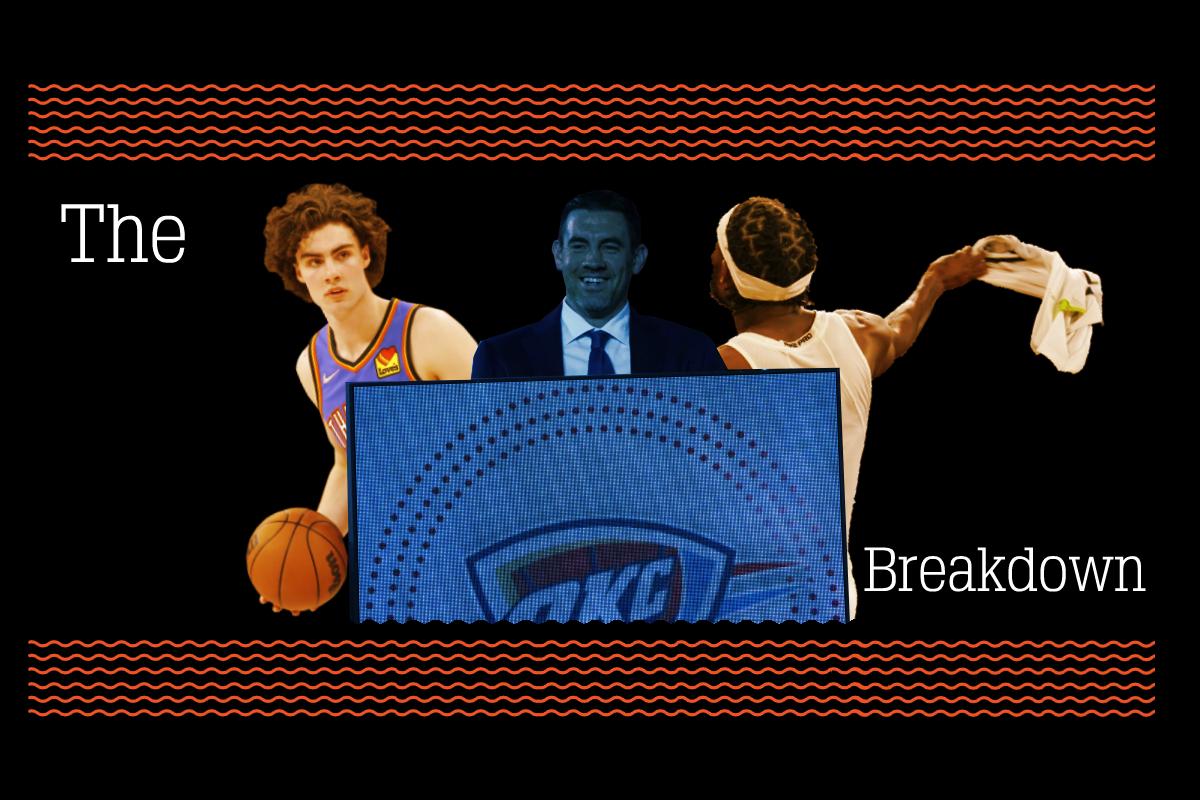
The Breakdown:
May 17 called for a toast among Thunder fans.
Following a 22-50 record in the 2020-21 regular season, the Oklahoma City Thunder entered the 2021 Draft Lottery with sky-high expectations. While most teams entering the 2021 lottery entered the ping-pong room with one crack at a top 5 pick – the Thunder carried two – their own selection, projected No. 4, and the Houston Rockets’ pick, projected No. 1. The catch to this golden deal is the Rockets’ choice was top 4 protected, leaving a near fifty-fifty chance for the Thunder claiming the pick at 5. In all, Oklahoma City had a near 76% chance of claiming one top 5 pick in this draw and a 25% slate at obtaining two top 5 picks.
Instead of scaling the draft board, the Rockets snagged the No. 2 pick in rising star Jalen Green while the Thunder mustered up the No. 6 pick in the class. Despite being a “five-man draft class” by most accounts, Oklahoma City found a diamond in NBL guard Josh Giddey – four Rookie of the Month awards later – it’s safe to say the Thunder came out just fine.
With a reshuffled deck and a flurry of G League call-ups later, the Oklahoma City Thunder continued their regular-season standing this season, capping their run with a 24-58 record, good for fourth-worst in the league. This go-around, the Thunder strolled into the May 17 draft lottery with a similar standing. But, this time, they were guaranteed a second lottery chip from the Los Angeles Clippers. As the envelopes were opened, the first Thunder logo struck at twelve, and the real nerves kicked in.
Holding a 48.1% cut at a top 4 pick, nerves were unsealed – but not Thunder cards. By the commercial break, Oklahoma City had cracked the top, then there were two, and then there it was – the highest pick in franchise history.
Going into the 2022 NBA Draft, the Thunder have their highest choice in franchise history (2) since relocating to Oklahoma City 13 years ago. Coupled with their high-caliber selection, their No. 12 pick from the Clippers, as part of the Paul George deal, calls for the first time they’ve held two lottery picks in a draft class.
The Clippers, who ended the season seventh-seeded in the West, lost two-consecutive Play-In games, prompting a second-lottery selection and a Patrick Beverley Kevin Garnett-Esque scorer’s table celebration.
Initially, a remnant from Chris Paul’s trade to Phoenix was presented with Pick No. 30. However, the Denver Nuggets acquired the pick, alongside two future second-round picks, in exchange for a 2027 first-round pick and JaMychal Green.
The Thunder’s third and final pick leading into tonight will be made at pick No. 34.
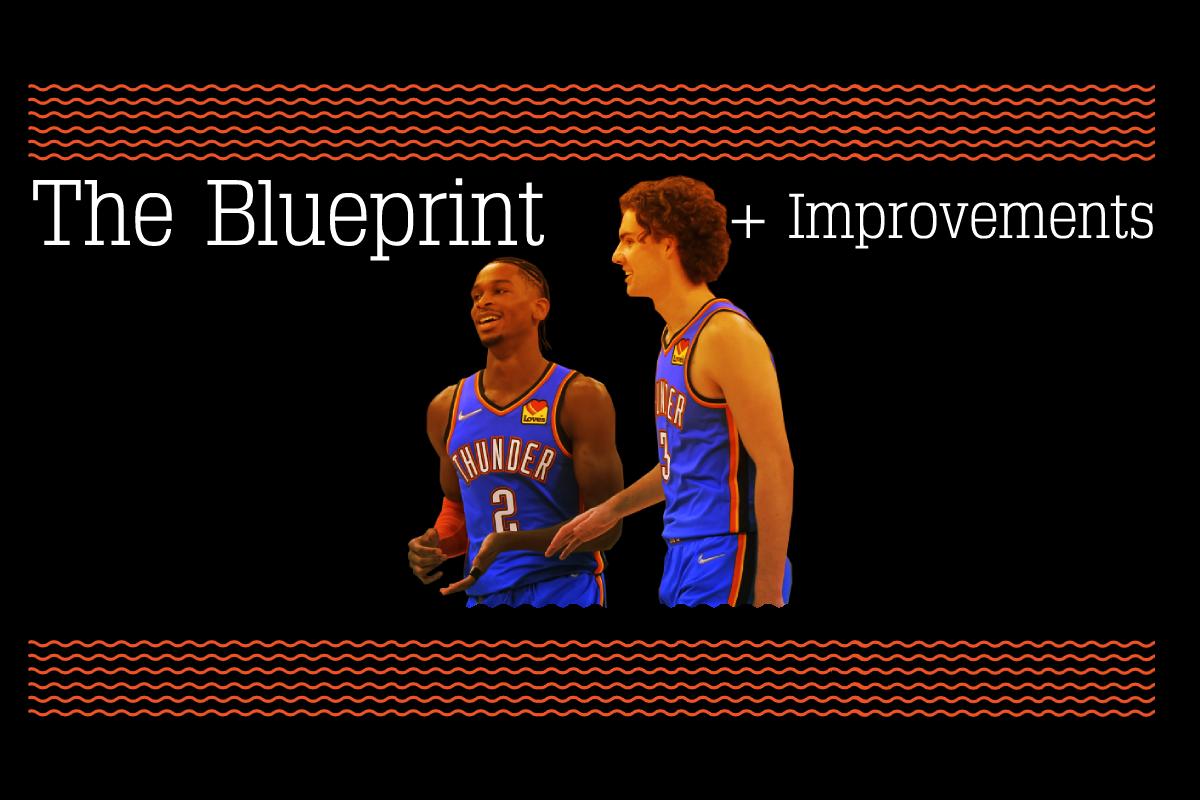
Bricktown’s Blueprint (And How To Build Upon It)
Following the Thunder’s revamp in the 2020 offseason, Mark Daigneault and company have begun a new page in the franchise’s storybook.
Leading the pack for Oklahoma City, fourth-year guard Shai Gilgeous-Alexander has set the example for the Thunder’s model. After one season playing behind Chris Paul in Bricktown, Gilgeous-Alexander took the reins in the 2020-21 season, and he has not looked back. In his two seasons post-Paul, the former Wildcat has pioneered Oklahoma City’s dribble-drive offense, leading in the NBA drives in both seasons.
Playing behind Gilgeous-Alexander, Josh Giddey has learned the ropes as the Thunder’s secondary playmaker, ranking second in rookie drives, placing 11.9 per game.
The Thunder have concocted their franchise around heavy backcourt play behind Gilgeous-Alexander, Giddey, and rookie Tre Mann. However, there are still some holes to fill in their ongoing process.
Frontcourt Play
The Oklahoma City Thunder have played rotational hot potato in terms of filling out their frontcourt these past two seasons. In the 2020-21 season, the Thunder held a solid five in veteran Al Horford. However, his age, coupled with potential trade packages, sunset the center shortly after the All-Star break. In his place, it appeared Presti had carved out prospects in Moses Brown and Tony Bradley to close the season. Ultimately, neither returned for this past season.
This back-and-forth of acquiring bigs for short-term situations carried into this season, notably in the two-way signing of Olivier Sarr. Generally speaking, the Thunder have lived by the motto of playing up a few sizes, electing to play traditional fours in Jeremiah Robinson-Earl and Isaiah Roby in primary stints at the five to cater towards the team’s frequent usage of high-ball screens.
Because they tended to play small, they sacrificed heavily in the rebounding department, allowing a league-high 48.4 rebounds against opponents and 11.0 offensive rebounds allowed per game.
When addressing the pecking order of organizational needs, solidifying their future five is a must in progressing in their overall rebuild.
Three-Point Shooting
Josh Smith is the lone man standing between the 2021-22 Oklahoma City Thunder and the worst catch-and-shoot record of all time.
269 out of 270. That’s how the 2021-22 Oklahoma City Thunder ranked in catch-and-shoot threes since tracking began nine seasons ago. The one team worse was the Josh Smith-led Detroit Pistons in 2013-14. The Pistons clocked a 32.5% clip on 14.0 attempts that season. Oklahoma City shot 32.6% on 27.2 attempts this past year. Needless to say they need significant help from deep.
Due to Oklahoma City’s isolation-heavy play, the franchise needs to emphasize placing sharpshooters around their backcourt to maximize overall play. Throughout the season, the Thunder were frazzled as defensive schemes to pack the paint, such as box-and-one, resulted in guards choosing between low-quality shots in the paint or open shots at the perimeter. It seems a no-brainer to kick the ball out in these situations, but there were hardly any consistent shooters playing off-the-catch.
With those who attempted 50+ catch-and-shoot threes, only two Thunder players shot above a 40-percent clip – Mike Muscala and Gilgeous-Alexander. For those shooting above a 35-percent threshold, Roby, Robinson-Earl, and Mann gave some relief.
To put things in perspective, the Toronto Raptors were 15th in the league in three-point catch-and-shoot makes at 36.6% – of those qualified, only four Thunder players shot above that benchmark. Due to the ample amount of non-shooters and two of their threats, primarily on-ball in Gilgeous-Alexander and Mann, it was a good investment to crowd the paint this season.
The Thunder’s top five options in the catch-and-shoot department last season, based on attempts, were Lu Dort (292), Darius Bazley (229), Jeremiah Robinson-Earl (162), Mike Muscala (161), and Josh Giddey (158). Outside of Robinson-Earl and Muscala, whose numbers were listed prior, there’s little consistency from their biggest contributors.
Thunder’s Top Catch-and-Shoot Targets:
Lu Dort: 91-of-292 (31.2%)
Darius Bazley: 71-of-229 (31.0%)
Josh Giddey: 39-of-159 (24.5%)
The need for catch-and-shoot cogs is undeniable for the Oklahoma City Thunder, especially when factoring in the frequencies of dribble-penetrations.
Shoring Up The Forward Spots
Positionally, the Oklahoma City Thunder’s biggest need is rooted in the center position. As aforementioned, every up-and-coming center during their rebuild has been utilized as a one-year rental – there are just no set-and-stone pieces there. At the forward positions, Sam Presti has assembled a collection of potential long-term pieces, but none of them have revealed their long-term placement on the team.
At the small forward position, the Thunder have a long-term piece at the ready in Lu Dort. Dort, age 23, has been one of Oklahoma City’s more consistent two-way options during the rebuild. However, his 6-foot-4, 6-foot-8 wingspan frame makes him a small-ball option at the three – potentially limiting roster capabilities. Any way you cut it, he’s a complete enough player to move up to the three. However, it’s evident his natural position rests at the two spot.
As for other players who’ve sifted into the small forward position, players such as Kenrich Williams and Aaron Wiggins have routinely slotted in as “glue guys” filling in at the two or three position when the rotation has an opening. Both of these players have shown to be great options in bench roles, but they’re not suited to be starters with this franchise. This same evaluation may be placed on rookie Vit Krejci, who would likely sway between the Oklahoma City Blue and Thunder organization if he returns.
The power forward spot has had many more resources allocated towards than the three amidst the rebuild. But, there’s still no conclusion as to how they will go about the position moving forward.
Oklahoma City has two main leaders in the power forward position in Darius Bazley and Aleksej Pokusevski, but neither has established their long-term footing. Over the last two seasons, Bazley has been the starting power forward with little hiccups in between. At 6-foot-8, he possesses good lateral quickness at the position, solid rebounding technique, and on-ball skills that fit the profile of a new-era four. The main concern comes with his scoring consistency, as his sporadic shooting outputs have put a dent into perimeter spacing, even resulting in a short relegation to the bench. When he’s firing at all three levels, he’s a great plug-in piece to the roster – but his lack of a proven shot has hindered him from a solidified starting gig.
Pokusevski is a much different player than Bazley, but his evaluation carries similar traits. At 7 feet tall and 200 pounds, Pokusevski is unlike any prospect currently in the league. The Thunder centered their 2020 NBA Draft on acquiring the Serb, dishing out two first-round picks and Ricky Rubio to select him. As a player, he, in theory, can do-it-all. He has impressive playmaking qualities, primarily as a passer, his shot release is light years ahead of most seven-footers, and he’s hard to guard when on fire. Just like Bazley, he’s still extremely shaky in production. This see-saw of shot charts led to G League assignments in both seasons in Bricktown – and though his potential is clear – he still has yet to contribute on a nightly basis.
Beyond Bazley and Pokusevski, a trickle-down effect is in order as Robinson-Earl and Roby would be power forwards on the majority of franchises at the current moment. Daigneault noted he’d like to transition Robinson-Earl to the four moving forward. So, it’s wise to keep the small-ball five pieces in the conversation.
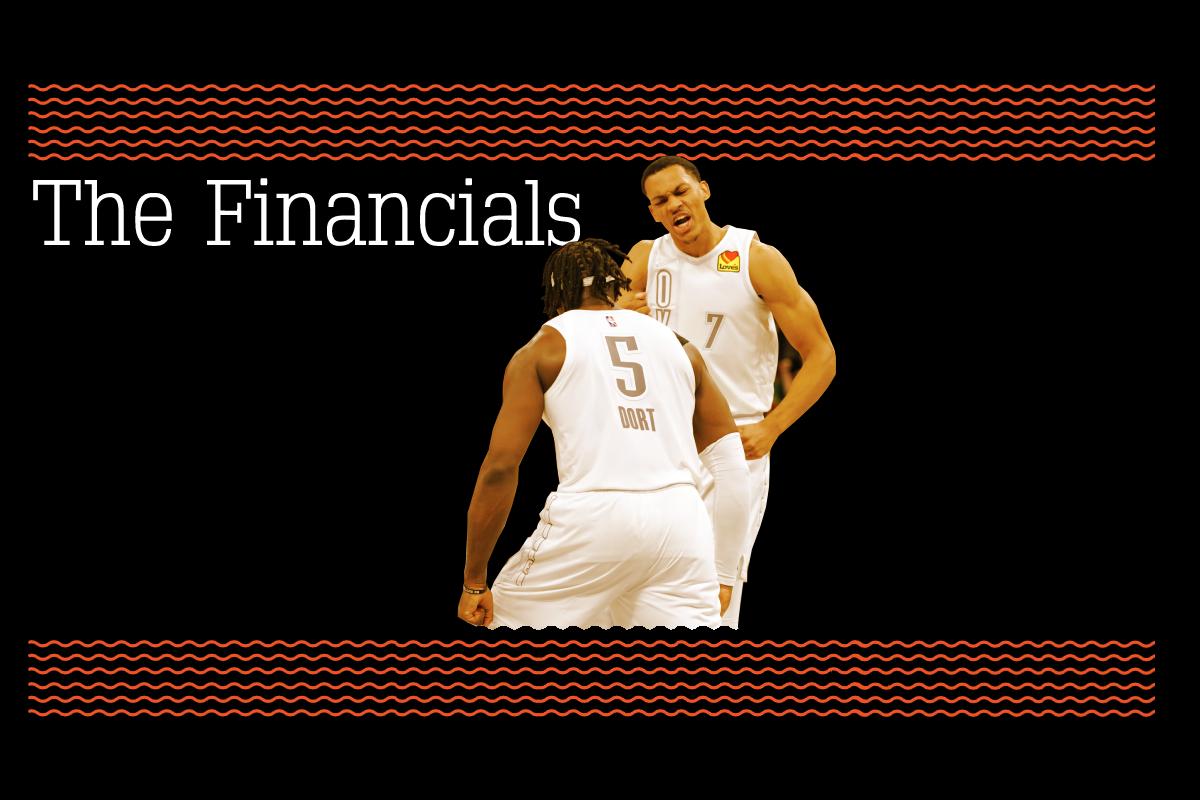
The Financials:
The Oklahoma City Thunder holds the largest amount of cap space across the league, and it’s really not a close contest.
Due to the Thunder’s roster consisting mainly of players on rookie-scale contracts or minimum deals – the organization spent all of this season way below the league salary floor. Following the Thunder’s acquisition of JaMychal Green last week, the Thunder still hang $23.4 million under the floor. However, the luxury to absorb deals will be wiped on June 30.
Because of Shai Gilgeous-Alexander’s five-year, $176.9 million contract extension kicking in on July 1, the Thunder’s ability to take on rehab projects such as Al Horford and Kemba Walker in the name of assets will be wiped from their playbook. Instead, veterans such as Derrick Favors and JaMychal Green would be financial chess pieces, using their expiring deals to conduct moves in the future.
Looking beyond this year’s draft class, the Thunder will be loaded with tough calls in regards to extending members of the 2019 NBA Draft class. With a record-setting 19 first-round picks on deck, rookie deals are alluring, and roster spots couldn’t be any harder to come by.
One of the marquee signings the Oklahoma City Thunder may take action upon may come this month with guard Lu Dort. Dort, who went undrafted in 2019, has a fourth-year option attached to his contract. If the Thunder exercise this option, he’ll be inked for $1.9 million next season, which makes him one of the top budget players in the league. The downside to this is he’d be an unrestricted free agent in the 2023 offseason.
On the flip side, the Thunder may decline his option by June 29, making him a restricted free agent this offseason. Though the short-term downside is apparent in cap space, it’ll allow the franchise to retain him long-term via matching the top offer.
Alongside the undrafted guard, 2019 first-round pick Darius Bazley is also due for a paycheck in the upcoming offseason. Bazley will make $4.3 million in the 2022-23 season while holding a $6.3 million Qualifying Offer if an extension is not met before next year’s extension deadline.
The Thunder have three non-guaranteed players on contract for the upcoming season in Theo Maledon, Kenrich Williams, and Aaron Wiggins. In all likelihood, Maledon would be the only of this trio on the outskirts of the roster.
Vit Krejci is partially-guaranteed for $781,759 this season.
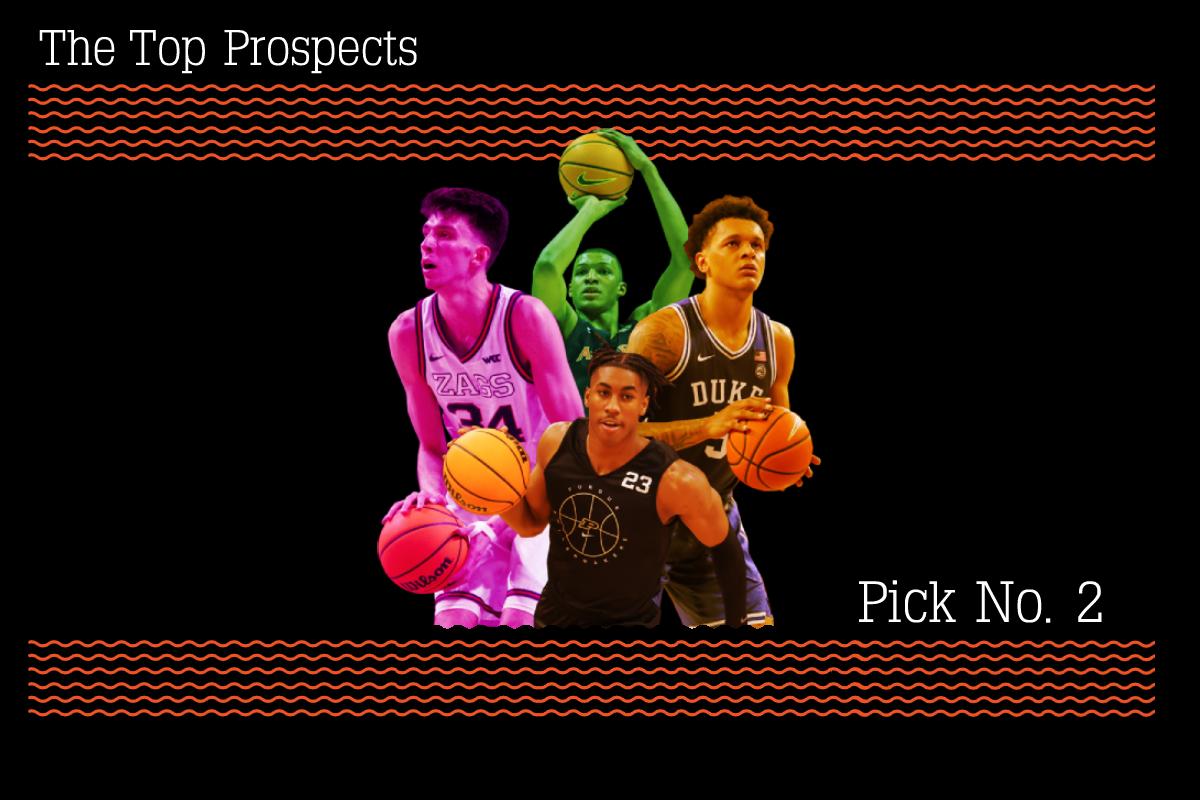
The Top Prospects: Pick 2
All eyes will be locked in on how the Oklahoma City Thunder go about navigating the top of the draft board. The Thunder’s No. 2 pick carries a slew of options in this particular draft as the cream of the crop prospects all check plenty of boxes the organization has been looking to check off.
(All evaluations excerpts from my scouting report series)
Jabari Smith
Jabari Smith is exactly what teams yearn for at the forward spot. With postseason teams finding major success disregarding positional locks and overall size – Smith is an ideal power forward who can be a perfect co-star with a small forward or members in the backcourt.
Smith, age 19, has been deemed the top shooter in this year’s draft class. In his lone season with the Tigers, Smith shot 42.0% from deep en route to averaging 16.9 points, 6.5 rebounds, and 2.0 assists across 34 games. To tag with this stat line, his 6-foot-10, 200-pound build makes him the lengthy shooter teams have desperately wanted.
His overall shooting ability is hard to come by at his size, and his overall speed and point of release make him a hard player to stop from downtown. Smith is a player who has mastered the catch-and-shoot game as he’s able to bury jumpers from almost anywhere on the court when open. To add to this, his hallmarked two-dribble pull-up is a jumper that should translate into consistent scoring outbursts moving forward.
Smith’s on-ball play does need some touch-ups as he lacks a go-to move to create distance from his opponent in halfcourt situations. Given his ability to make shots off the bounce already, adding some marquee dribble moves gives him the seeds to be a good isolation piece. If his handling ability never comes to fruition, I think he could still find success working out of high-ball screens.
Defensively, Smith’s overall frame fits the bill for what NBA teams are looking for. His length and overall lateral quickness make him a chess piece able to defend 2-4, and with a high motor and active hands – he wouldn’t be terrible defending the post in stints.
The Fit:
For the Oklahoma City Thunder, targeting a player such as Jabari Smith would be nothing short of a perfect marriage between the two parties. Per Synergy, Smith ranked in the 85th percentile as a catch-and-shoot target at Auburn this season. If you combine that hardy stat with his limitless range and well-oiled jumpshot – you have a lethal off-court threat to play alongside Gilgeous-Alexander and Giddey.
In terms of how his development coincides with the Thunder blueprint, he slips in perfectly as someone who can play second or third fiddle in the offense. But, with one of his biggest question marks resting in his isolation ability, he’ll need additional reps playing on-ball. Because the Thunder have been all hands on deck with recent draftees, handing the forward an on-ball role in stints would most definitely be in the cards, allowing him to blossom offensively with the backcourt.
(Full scouting report on Jabari Smith can be found here)
Chet Holmgren
Chet Holmgren is a unique talent that you won’t find in any given draft cycle. His excellence around the basket, the perimeter, and even creating for himself is uncanny for a seven-footer – and with a bulk in the cards, he’ll be a handful for other teams for years to come.
With his agility, Holmgren is an elite pick-and-roll player as if his three-pointer stays a float, he’ll be insanely difficult to cover as his frame makes him a deadly roll man while his ability to pop also can torch defenses. Around the basket, his footwork and overall grittiness to take contact also make him a threat.
Holmgren is a name to watch in the shot-blocking category for years to come as well. Collegiately, he stayed disciplined in the foul department while providing rim protection both standing and on the move.
If he manages to check the boxes as a shooter and as a ball-handler, the sky becomes the limit for Holmgren. He is a bit clunky taking up the basketball now, but once in space, he’s a player who can erupt both pulling up at the three or slashing to the basket for penetrations.
In terms of versatility, it’s hard to find a player more fitting than Holmgren. Barring injury, he’s a high-floor, high-ceiling prospect who can yield you stats any day of the week. And his hybrid of speed and self-creation puts him on the map for sliding down to the power forward spot as well if need be.
Holmgren still needs to hone in on mastering both his on-ball creation and handle to limit potential inconsistencies in his play. But, even with his current archetype, he’s a contributor who should be able to make an impact right away on both ends of the ball as he slips right into most systems as a screen setter who can both stay outside and defend on the other end.
The Fit:
Chet Holmgren easily checks the most boxes by a prospect in this year’s draft class.
Oklahoma City has desperately needed a long-term answer for their center situation, as while playing smaller players up a few sizes has its benefits, it also won’t yield the long-term success necessary to propel them out of their ongoing rebuild. In selecting a seven-footer in Chet, the Thunder obtained their first true center via draft since Dakari Johnson in 2015. The selection would also mark the Thunder’s first center selection in the lottery since Steven Adams in 2013.
The Thunder’s space-and-pace play has needed a stretch five in the mix. With Holmgren, not only does he provide the spacing necessary, but he also has shown flashes to create off of DHOs and through top-of-the-key pull-ups in transition. Defensively, his overall agility also solves an issue that plagued the Thunder in previous playoff runs as his versatility on screens adds an element centers such as Adams and Enes Kanter could not provide in the postseason.
(Full scouting report on Chet Holmgren can be found here)
Paolo Banchero
Paolo Banchero is a special offensive talent.
Banchero, age 19, is well-equipped for the jump to the next level. With a 6-foot-10, 250-pound frame, he’s already the ideal slab at the forward spot, he just needs some chiseling. In his lone year with the Blue Devils, he averaged 17.2 points, 7.8 rebounds, and 3.2 assists for Duke across 39 games.
His seasoned mid-range game and shot mechanics make him a player who should be able to be a competent three-level scorer. As a ball-handler, he has the handling ability that requires a team's “swiss-army knife” defender who is handsy at the perimeter, can cut off driving angles, and contest on the interior. Even when faced with a team’s primary defender, Banchero is someone who should be able to yield some success working on the deck, and if stifled with his shot, his passing vision should come in handy.
Banchero’s physical nature on both sides of the floor may need a few tweaks, but his energy level is a plus. He’ll be able to create fouls inside, and with a jumper, his net of foul methods should increase. This hustle caters towards his rebounding efforts, as he’ll be a good transition player as a self-creator or outlet passer.
Defensively, Banchero should be sound. His weak-side play and moments of success switched onto guards are enough to believe he’ll hold up when faced against heavy screen-setting teams, which is a good sum in today’s NBA.
With the ball in his hands, Banchero is a player who’ll be able to get a bucket. Off the ball, he’ll make a significant impact, even as an average three-point player.
In terms of role, Banchero is a player slotted as a secondary playmaker who can be entrusted with a high volume of on-ball situations when needed. He’s the ideal archetype to play as the co-star to a backcourt piece.
The Fit:
Paolo Banchero is not a slam dunk fit for the Thunder organization per se. However, there’s a legitimate case for him to be the best prospect in this year’s draft. I am in this camp.
Banchero’s handling ability at his frame is nothing short of special. He can put the ball on a string and create openings at all three levels for himself in isolation possessions. He’ll need to fine-tune his three-point shot. However, even at the base level, he’s a player that would add fire to the flames in Oklahoma City’s penetration furnace. The clear overlap here is that Banchero is a primary on-ball figure which is not the smoothest fit alongside Gilgeous-Alexander and Giddey. But, if the Thunder are confident in his catch-and-shoot game development – he’d undoubtedly add the most lethal frontcourt threat Oklahoma City had carried since Paul George.
The fit is not the smoothest here, but if the Thunder place talent in the forefront of their picking preference, Banchero would be an ideal fit for the franchise. There is no ceiling to his play, and at the bare minimum, he adds even more firepower on the playmaking front.
(Full scouting report on Paolo Banchero can be found here)
Jaden Ivey
Jaden Ivey took major strides this season with the Boilermakers. His ability to take over games with his freakish athleticism, acceleration, ball handling, and shot-creating give him the core pieces to be a successful producer at the next level.
Ivey, age 20, made some noise as a Freshman, but his breakout campaign as a Sophomore has him soaring up draft radars. At 6-foot-4, 200 pounds, Ivey has a build akin to a modern-day point guard. But, with an elite ability to play above the rim – he’s slotted in at either guard spot.
Ivey finished the year averaging 17.3 points, 4.9 rebounds, and 3.1 assists across 36 games.
Ivey is a player who should be able to create offense out of thin air when penetrating to the basket, and if a pull-up develops, there’s no good option when defending him in space. Because of the guard’s uncanny speed and athletic ability, he has a clear advantage over some of his peers, making him a franchise’s first or second option as a scorer.
Prospects such as Jaden Ivey do not roll around in every draft class. His wide array of offensive attacks will make him a tough cover moving forward, making him a player who could lead in scoring on any given night.
Jaden Ivey fits the mold of an All-Star caliber scorer. He possesses the elite athletic ability, a quick handle, the ability to create his shot, and shades of being a three-level scorer. If you top this off with him being able to slow down in stop-and-pop situations, better playmaking in the halfcourt, and better defense against screens – he’s the high-output scorer franchises can build around.
He’ll need reps, particularly in catch-and-shoot and mid-range situations to fully fill out his offensive game. Under the assumption he becomes a reliable scorer at all three ranges, him becoming the primary or secondary scoring option is well within reach.
The Fit:
Under the assumption no trades are made, there will be some tough rotational decisions if the Thunder elect to select Jaden Ivey with the No. 2 pick in the draft. Ivey’s predicament is basically the polar opposite of Banchero. While Banchero’s main concern is playstyle overlap, Ivey’s potential issue would lie in position. However, if Ivey is valued as one of Oklahoma City’s top prospects, which there is a case for – the positional woes would be tossed on the backburner.
His offensive skill set would undoubtedly create must-watch TV playing alongside Gilgeous-Alexander and Giddey. With his elite on-ball skills and some added help as a mid-range creator. He’s an isolation threat who can put anyone on a poster. On the flip side, he’s a solid off-ball piece who could play off either member in the catch-and-shoot department.
A clear ripple would be created by selecting Ivey without offloading a current member of the roster. A three-man group has been established in Gilgeous-Alexander, Giddey, and Dort, and Mann is the presumptive guy in the sixth-man spot.
(A full scouting report on Jaden Ivey can be found here)
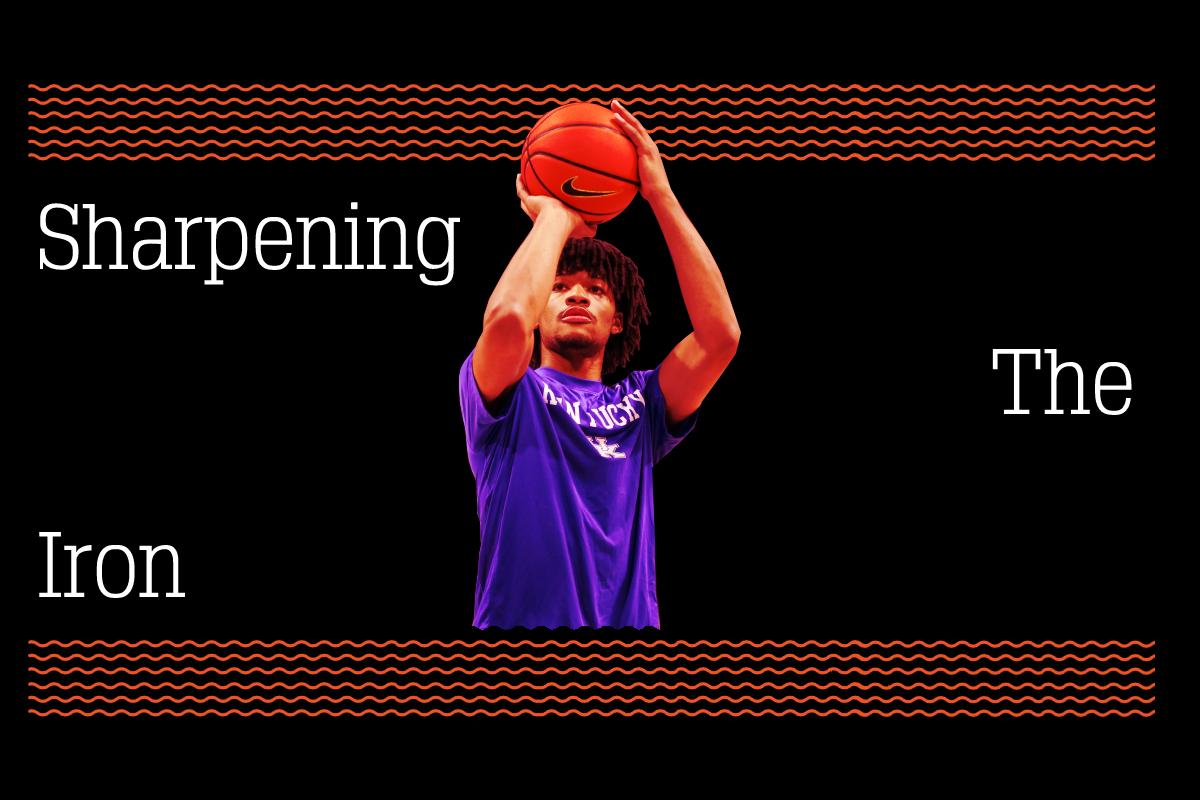
Sharpening The Iron
The markings are there to indicate the Oklahoma City Thunder have held ties with another top-tier prospect. But, unlike the top four, he ranks in a middling class outside of both the Thunder’s selections.
That player is Shaedon Sharpe.
Sharpe, age 19, started the 2021-22 school year playing for Dream City Christain, a private high school in Glendale, Arizona. However, with Sharpe having completed all high school credits before the fall semester, he withdrew from the school, enrolling with Kentucky in January.
Offensively, Sharpe has shown to be an elite athlete. In his tenure at Dream City Christian, Sharpe became the go-to target for alley-oop dunks as his explosiveness around the basket routinely made impossible finishes look like clockwork. His burst around the basket translates on the deck as he’s prone to finish through contact will mid-air adjustment aplenty. Sharpe won't lead you as a ball-handler. However, his current array of moves has helped him make room at the perimeter. As a scorer, Sharpe has yet to reach the three-level status as his jumper was both on the slower side and inconsistent in high school. But, when he found success with his jumper, his game didn’t have too many parameters. He’s a project piece at the perimeter, but he should be an effective slasher and cutter from the jump.
Defensively, Shaedon Sharpe has yet to face premier competition, but he’s had some moments. To tag with his 6-foot-6 height, Sharpe’s 7-foot wingspan makes him the prototypical build for a defensive wing. At the high-school level, he did a great job laterally playing perimeter defense and on the interior, he had great timing to both reject and alter shot attempts. The jump from high school to college is significant in terms of defensive ability, both in talent and scheming. But, there’s a clear mold to build off of with Sharpe.
When looking at the draft board solely off of potential, Sharpe has a legitimate case of being a top 5 candidate in this year’s draft class – and a player the Thunder may be interested in moving forward. At age 19, Sharpe has the lethal blueprint as a scorer with his explosiveness inside and moments of excellence in self-creation. With Oklahoma City reportedly evaluating Sharpe more closely than any other franchise, he’s a prospect likely outside of both their lottery selections’ ranges; but the talent is evident.
However, due to Sharpe’s year being absent from play, there are question marks. Particularly, if he’s able to solidify himself as a perimeter piece due to his inconsistent three-point play this season. Additional improvement will also need to be made in shot creation as he’s far too reliant on stepback attempts.
To Trade Or Not To Trade: Pick 12
While the biggest card in the Thunder’s stack of offseason duties comes in managing the No. 2 pick in the draft class – there’s still a significant amount of impact that will be had at pick No. 12. This selection, which came as part of Paul George’s trade to the Los Angeles Clippers, sets the Thunder in a position to take one of two things: trade the pick or select a prospect.
Trading the Pick
It’s no secret that the Oklahoma City Thunder have the best draft outlook in the league. The organization owns 19 first-round picks until 2027, and with the finalization of their exchange with Denver – every single draft year will come with multiple selections, barring pick protections.
Because of the Thunder’s treasure trove of future assets, they are immediately the team to call when looking to secure long-term protection via draft. You might be able to swindle one of their four 2027 second-round picks while you’re at it.
Due to these picks, pairing them with the No. 12 pick in this class would make an enticing package to teams lurking in the middle of the lottery. This is an extremely unique lottery as a good cut of mid-lottery teams fell into their respective positions due to injuries and trades made throughout the year. That sentiment can be expressed with the Trail Blazers, who select at No. 7, and the New Orleans Pelicans, who select at No. 8.
For the Thunder, the luxury of these additional picks is that they have some cushion when it comes to unloading draft capital in deals. While it’s expected that the franchise remains in asset accumulation mode, the prospect of shelling out a future first-round pick or two to trade up a few spots for what they herald as a star seems to be a worthy investment.
Pick No. 4 - Sacramento Kings
As the rumor mill has swirled, the Thunder have been pegged as a team who may be interested in acquiring the No. 4 pick from the Sacramento Kings in an effort to acquire Jaden Ivey. Under this deal, they’d undoubtedly be in a bidding war for the pick, but with a base of the No. 12 pick and a player such as Lu Dort – they can pile on picks Vivek simply cannot deny. It should be noted, however, that the Kings would likely receive much better win-now offers for this pick, but Bricktown would most definitely have a shot if Sac-town played the long game.
Pick No. 7 - Portland Trail Blazers
While the idea of the Thunder trading up with the Sacramento Kings is franchise-altering for the Thunder, the likelihood of such a deal going through would be slim under the Kings’ current trajectory.
At pick No. 7, the Portland Trail Blazers present a realistic option for the Thunder to trade up with. With the Trail Blazers having a backcourt with Damian Lillard and Anfernee Simons, a recently-acquired Jerami Grant, and a top-tier center in Jusuf Nurkic – Portland is at a crossroads with their pick. On one hand, they can make this pick for a two-way forward or a high-ceiling prospect, or they could ship this pick and provide Lillard immediate relief. The Thunder could offer such a deal, packaging a deal surrounding Lu Dort and pick No. 12.
This price is insanely steep as is. Dort has proven to be a marquee piece in playoff situations, and you’d be shelling him out to move up five spots in the draft. That’s ridiculous value for the Blazers’ camp, but, similar to the Kings mock – Oklahoma City makes this move in efforts to select “their guy.”
Selecting a Player
If the Thunder stand pat at No. 12, which is the most likely outcome, there will be plenty of targets the franchise could pick with this selection.
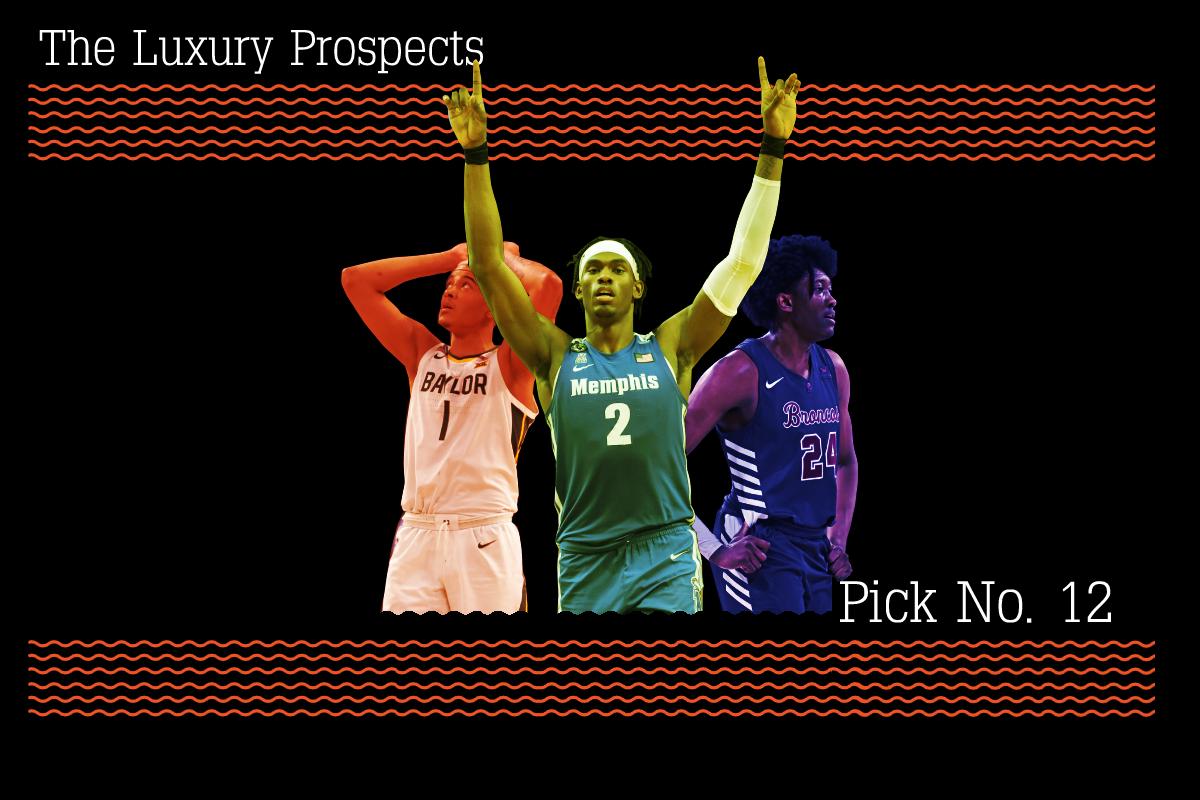
The Luxury Prospects: Pick 12
Because of the dominoes that fell for the Los Angeles Clippers to fall from a contender to a playoff miss – the Thunder holding this pick in the lottery is nothing short of a miracle. Based on this, this is a luxury pick for the franchise.
Here are some options for the No. 12 pick:
Ousmane Dieng, Forward, New Zealand Breakers
Marquee Stats: 8.9 points, 3.2 rebounds, 1.1 assists
When you look at Dieng offensively, he made his money’s worth operating in the pick-and-roll. Dieng is quite nimble for 6-foot-10, and with a 7-foot-1 wingspan, he’s able to loft passes over guards and bigs alike to his roll man while surveying for cross-court dimes. He also showed flashes of self-creation from three. But, the success came in segments.
Defensively, Dieng is the ideal project piece. He exchanged reps playing 1-3 this season, and with his size and agility, he was able to soar up for some blocks, too. Dieng shifts his feet constantly on defense, which could lead to some fallbacks. But, he is great at regaining this lost space.
If the Oklahoma City Thunder are looking to go for the potential grand slam at Pick No. 12 – Dieng deserves to be in the conversation. His length and blend of defense and passing ability gel right into the Thunder’s system. He needs to roughen out a few edges, but at 18, there’s room in the figurative growth plates.
The Fit:
Dieng is the low-ceiling, high-upside prospect that’d make sense in Oklahoma City. There’s a clear need for a future three, and Dieng may fill, but he’s also clearly a project that may take a few years to uncover – potentially slotting him in a similar spot to Bazley or Pokusevski.
AJ Griffin, Wing, Duke
Marquee Stats: 10.3 points, 1.1 rebounds, 48.3% 3PT
AJ Griffin is nothing short of a sharpshooter. With an impressive shooting form, a feel in catch-and-shoot situations, and an emerging mid-range game – he’s a plug-and-play three who can relieve floor spacing.
Offensively, his best strength comes as a sharpshooter. Griffin knew his role at Duke. He launched more threes than twos this season, nailing 48.3% of his 155 tries. Griffin’s best play is generated off-the-catch in the wings or corners, while his impressive high school reel suggests there might be more to his methods of scoring.
Defensively, Griffin has measurables akin to a 3-and-D wing. He’s 6-foot-6 with a 7-foot wingspan while carrying the upper-body strength to absorb contact while defending.
The Fit:
Oklahoma City would need to feel confident in his medicals, as he missed two years in high school to injury, but he checks the boxes when healthy. Griffin’s role as a catch-and-shoot target is exactly what the Thunder need, and at 18, there’s room for him to hone in from here.
Jalen Duren, Center, Memphis
Marquee Stats: 12.0 points, 8.1 rebounds, 2.1 blocks
Duren is the up-tempo lob threat franchises are chomping at the bit to grab. With an explosive first step off of high-ball screens, Duren can run into the lane for loft passes over his defender and alley-oop passes which end on a highlight reel. His under-the-basket activity is what has made his stock as he’s an interior enforcer who gets down the court faster than most bigs.
The rim protection is the talking point for Duren’s defensive play. He capped the season averaging 2.1 blocks for the Tigers, finding these stats from standstill rejections and chasedown blocks. The speed from Duren is the key note, however, he still needs to work on both off-ball defense and boxing out.
The Fit:
Duren is still a project piece moving forward. However, his elite athletic ability and youth at 18 years old make him a hot name to watch in the lottery. On paper, Duren is an excellent fit with Shai Gilgeous-Alexander and Josh Giddey as a screener. But, his lack of a consistent jump shot is a potential pushback as this deficiency could lead to centers playing in drop coverage.
Mark Williams, Center, Duke
Season Averages: 11.2 points, 7.4 rebounds, 2.8 blocks
As the ACC Defensive Player of the Year, Williams adds unprecedented size to a roster at 7-foot with a 7-foot-7 wingspan. In terms of playstyle, Williams is an ideal rim protector and lob threat for a franchise as his interior play was one of the top calling cards for the Blue Devils this season.
Williams was the sidekick to top prospect Paolo Banchero this season, excelling in slips to the basket on screens for dunks and finishes alike. He’s a top-tier interior threat in terms of paint play as his hybrid of athleticism and length made him a tough cover. Second-chance points are also in the playbook for the big, averaging 2.6 offensive rebounds per game.
On the defensive side, Williams is a trusty interior defender. His ability to contest shots without fouling (2.1 FPG) made him a stellar Sophomore this season.
The Fit:
For the Thunder, tacking on a player such as Williams immediately strengthens paint defense, however, his lack of a mid-range shot could stifle dribble-drive play. On the bright side, he did shoot 72.7% at the charity stripe this season.
Jalen Williams, Wing, Santa Clara
Marquee Stats: 18.0 points, 4.4 rebounds, 4.2 assists
As a junior, Jalen Williams rose from an elite role player for Santa Clara to being far and ahead of their No. 1 option. With full control of the offense, he managed the offense at the two spots both yielding success as a playmaker and three-level scorer.
Offensively, Williams is not going to wow you with his handling ability, however, he still can pick his spots. He’s shown promise navigating the pick-and-roll to find teammates outside of creating his own looks. Off-ball, he’s a lethal catch-and-shoot target who's also caught his stride in DHO scenarios. Even at the basket, he’s a strong attacker who can sky up for sneaky dunks both on-ball and via cutting.
Defensively, Williams is a premier piece at the guard spots. At 6-foot-5 with a 7-foot-2 wingspan, he has the ideal length to defend multiple positions. He has solid lateral quickness, allowing him to keep smaller guards from creating angles while also being able to close out on triples.
The Fit:
Most mock drafts have wiped Williams entirely out of lottery consideration. However, he’s the perfect off-ball fit next to Gilgeous-Alexander and Giddey, even at pick No. 12. He’s a complete catch-and-shoot piece who also has experience creating plays for others with his passing vision. It may be deemed a reach to take a 21-year-old such as Williams, but his skill set gives him the makeup of a steal.
Jeremy Sochan, Forward, Baylor
Marquee Stats: 9.2 points, 6.4 rebounds, 1.3 steals
Sochan, age 19, capped this season with Big12 Sixth-Man of The Year honors. With the Bears, he rose draft boards as his 6-foot-9, 230-pound frame has scouts dazzled by his potential defensive versatility.
Offensively, Sochan has shown promise as an interior finisher. But his scoring range is still murky. He shot in the 50s at the line and his three-ball, while small in sample size, translated to sporadic games.
Defensively, he carries a ton of potential. Sochan has great lateral quickness, making him a swiss-army knife on screen defense. His rebounding prowess also makes him a great candidate to be a late-game producer, assuming his jumper develops.
The Fit:
On paper, Sochan’s fit with the Thunder seems ideal. Oklahoma City is enamored with lengthy defenders and he is just that. The one bump is his perimeter play, which if not developed, would prolong the organization’s spacing troubles. But, he’s an indefinite plus to the team’s defensive play.
Jaden Hardy, Guard, G League Ignite
Marquee Stats: 17.7 points, 4.6 rebounds, 3.2 assists
All the attention surrounding the Thunder’s backcourt situation has revolved around Jaden Ivey and Shaedon Sharpe via trade-up. However, another high upside swing is here in Jaden Hardy – and Oklahoma City wouldn’t need to shovel out assets.
Hardy, age 19, was a consensus top 5 prospect going into this year, but a shaky shooting display with the G League Ignite pushed him outside a projected lottery seed. That doesn’t mean he’s not extremely talented. Hardy has a tight handle on the ball, has shown to create space in isolation, and carries three-level scoring potential. He’s a springy athlete who can burn you on pull-ups, stepbacks, and more. He, in theory, has all the tools to be a high-tier scorer.
Defensively, Hardy is nothing special. He did haul out 1.3 steals per game. But, at 6-foot-4, he only projects to defend his current position at this given moment.
The Fit:
The fit is not great with Hardy, especially with no trades to select him here. The upside here is Hardy has more on-ball skills than a player such as Sharpe but is more lacking in athleticism. He’s a high-ceiling player who would harden the fourth backcourt spot with Gilgeous-Alexander, Giddey, and Mann.
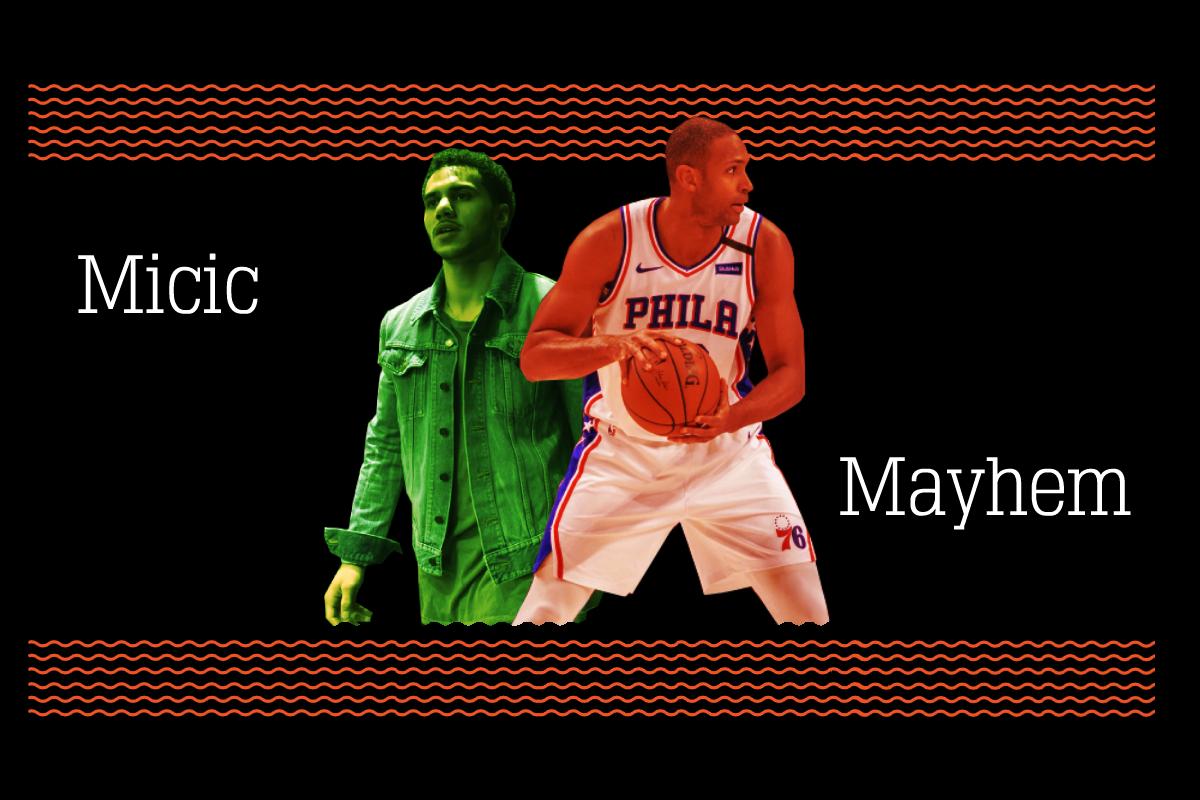
Micic Mayhem
Following the finalization of JaMychal Green’s shift to Bricktown, the Oklahoma City Thunder will carry 16 members on their roster heading into draft day. However, there’s a 17th man looming on Thunder radars.
That player would be guard Vasilije Micic.
To give some context on the situation, the Oklahoma City Thunder acquired the draft rights to Micic in December 2020 in a deal that sent Al Horford, Theo Maledon, Micic, and a 2025 first-round pick to the Thunder, from the Philadelphia 76ers, in exchange for Danny Green, Terrance Ferguson, and Vincent Poirer.
Basically, Micic, who was selected 52nd by the 76ers in 2014, was considered to be nothing more than a throw-in for this deal. However, as his career has progressed – so has his NBA market.
In the last two seasons, the 6-foot-5 guard has risen from being a top player in European circles to being a solidified superstar in EuroLeague circles. Alongside this, he’s been a contributing piece in Europe’s premier duo in former first-round pick Shane Larkin and Micic.
Last season, Micic took home EuroLeague MVP honors averaging 16.1 points and 5.0 assists across 33 appearances. With his contract with Anadolu Efes expiring, the opportunity was presented to make an NBA leap. He passed on the offer, returning to defend the franchise’s league title.
Micic successfully defended the EuroLeague title this season, earning Final Four MVP honors with an effort highlighted by a game-winning shot in the semifinals.
Now, at age 28, Micic has the chance to make the NBA leap yet again with an opt-out clause in his contract. As one of the top players outside of NBA ranks, Micic would undoubtedly up a franchise with his crafty playmaking and off-ball creation ability.
With Micic suggesting an NBA jump, the Thunder could have a potential trade chip in moving his draft rights. Due to the guard not signed to an NBA deal, Oklahoma City may trade his draft rights during the draft or offseason process in exchange for assets – allowing the guard to play in a more favorable backcourt environment.
Micic’s overall trade value is unknown at this point as, if he makes an NBA jump, he has an uncanny resume for incoming point guards. However, it’s hard to see a bidding war for the guard being in the cards, especially given last year’s shake-up.
There’s an incentive for Micic to play at the highest level. However, he’s a superstar with Anadolu Efes – and that sentiment would only increase if he returns. Because of this, all of the leverage is on Micic’s side as if the Thunder cannot place him on a team he’s hellbent on playing for, there’s no pressure for him to make the leap now.
Ideally, the Thunder’s best option is to try and gauge which teams Micic would make an NBA jump for, and try and concoct a deal from there. Under the assumption that Micic has teams in mind, Presti could attempt to negotiate a trade package that ships out Micic for future draft capital.
In negotiations, GMs would not be expected to trade for Micic’s draft rights without a promise of signing an NBA contract with the franchise. Because of this, it’s more likely that the guard would be dealt in a gentlemen’s deal, likely for a pair of seconds. However, in a package deal, his value could potentially tilt the scales on moving the Thunder’s No. 34 pick to a first-round pick.
With the Milwaukee Bucks and Chicago Bulls reportedly interested in the guard, attempting to reclaim a third first-round pick could be in the cards. The Bucks, who carry the No. 24 pick, would be the more likely of the two based on draft positioning.
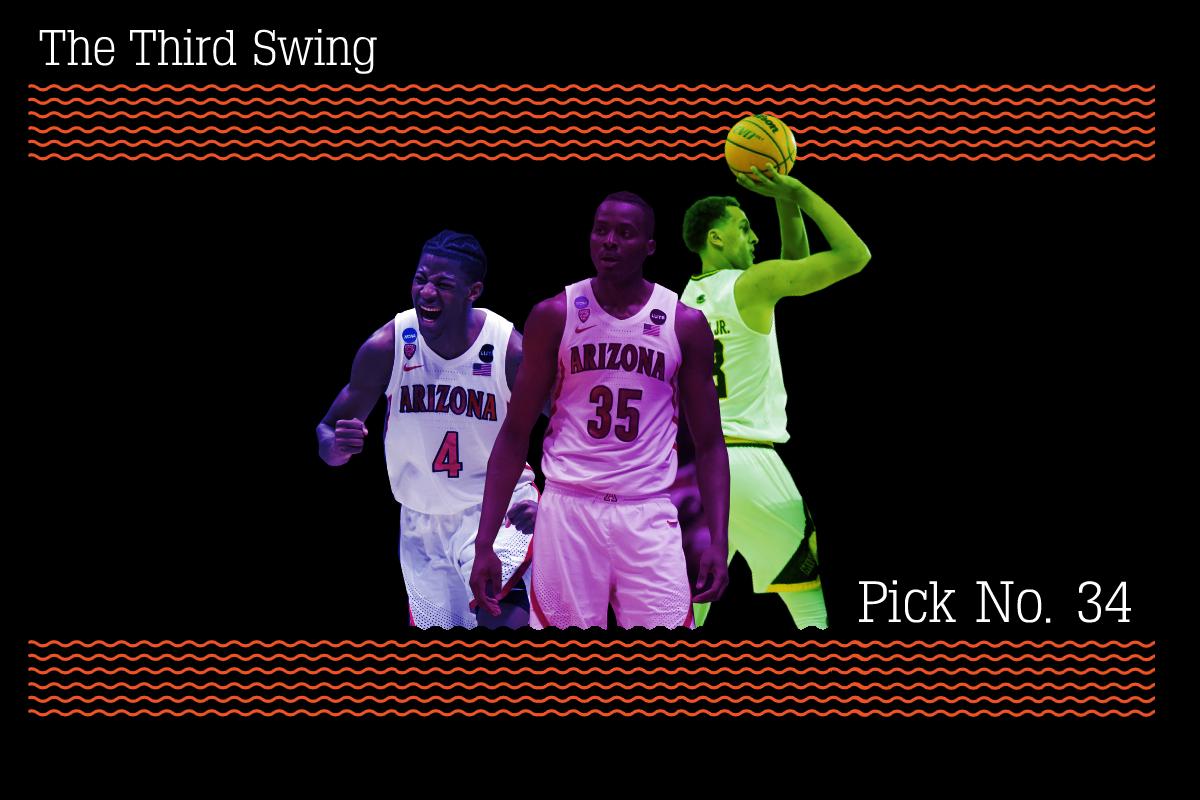
The Third Swing: Pick 34
The Oklahoma City Thunder have a history of exhausting late-first round and early-second round choices on high-floor prospects who project to be solid role players in the long run. This pattern was displayed last season as the organization traded picks 34 and 36 to acquire the No. 32 pick for Jeremiah Robinson-Earl – arguably the safest player in his draft range.
On the flip side, the Thunder have also had a few outliers. Two seasons ago, Sam Presti selected an intriguing combo-guard in Theo Maledon and moved up the board to select Vit Krejci with the No. 37 pick. In obtaining Krejci, the Thunder offloaded the 53rd pick, and a future second-round pick. Krejci, who suffered a torn ACL just three months prior, was undoubtedly selected with potential in mind.
In this draft cycle, the Thunder have one chip in the early-second round here with pick No. 34. With the franchise carrying a record-setting haul of picks, there’s reason to swing for the fences here. But, their impending roster crunch also makes going for a high-floor player a viable strategy.
Here are some prospects to watch at pick No. 34:
Patrick Baldwin Jr., Forward, Milwaukee
Marquee Stats: 12.1 points and 5.8 rebounds
Patrick Baldwin Jr.’s Freshman did not go according to plan.
As a consensus five-star prospect, Baldwin Jr. had an assortment of blue bloods calling his name. Instead, he elected to play for his father at UW-Milwaukee.
Expected to be a foregone lottery selection, Baldwin Jr. struggled mightily with the Panthers averaging 12.1 points and 5.8 rebounds while shooting 26.6% on threes. Due to a season-ending ankle injury, he called his season quits after 11 games.
In theory, Baldwin Jr. is an ideal perimeter piece at the three. He has a quick release, has shown flashes of limitless range, and has a great ball-handling arsenal for 6-foot-10. The downside to this is his overall inconsistency and disappointing combine outing – marred by a 26.5-inch vertical leap.
The Fit:
If brought to Bricktown, Baldwin Jr. is a great developmental piece moving forward. He’d likely be handed a similar path to 2021 first-round pick Jalen Johnson, who spent most of last season in the NBA G League. However, in the Blue’s system, he’d have great support from Grant Gibbs, a returning Lindy Waters III, and have the cushion to develop with in-game reps.
Christian Koloko, Center, Arizona
Marquee Stats: 12.6 points, 7.3 rebounds, 2.8 blocks
Christian Koloko was one of the top rim protectors last season, earning Pac-10 Defensive Player of the Year honors and national consideration.
At age 21, Koloko is older than some players currently on Oklahoma City’s roster. However, he adds a new tang as he’s 7-foot-1 with a 7-foot-5 wingspan. Due to his size, he’d immediately patch the five spot, especially if the Thunder don’t take a big in the early moments.
He’s a solid interior big who does a good job setting screens, rolling to the cup, and converting under the cup. Defensively, his interior shine is apparent as he excelled prowling in the paint for contests and blocks. Overall, he’s a seasoned interior threat, but he’ll need to fine-tune his shot.
The Fit:
Koloko is a sturdy option at the center spot. While the Thunder have tended to use flat-footed centers as short-term pieces – Koloko’s current base makes him a trusty role player with some hidden potential. At Arizona, Koloko hardly utilized his jumper, however, he shot in the 70s at the stripe and went 16-of-25 at the NBA Combine’s three-point drill. If he adds a pop game, he easily trumps former fill-ins. At his floor, his role would be akin to Tony Bradley.
E.J. Liddell, Big, Ohio State
Marquee Stats: 19.4 points, 7.9 rebounds, 2.6 blocks
E.J. Liddell was one of college basketball’s top players for the past two seasons, pioneering the Buckeyes’ offensive with some inside-out play.
Liddell has some intrigue playing at the four as his 6-foot-7, 240-pound build gives from a solid base. Offensively, he’s a good player working out of the post for face-up opportunities but also in kick-outs to the perimeter. To add to this trait, he’s also drastically improved his range – making him a solid pick-and-pop piece off a screen.
Defensively, Liddell carries value in the frontcourt as he’s built enough to play small-ball five in stints or stick to his natural position. He can recognize weak-side defense and he’s a smart switcher in the halfcourt.
The Fit:
While Liddell is a more ideal piece for a win-now franchise, his ability to play in the pick-and-pop and make smart passes make him a high-floor player akin to Jeremiah Robinson-Earl from last year's class. If the Thunder are not sold on any first-round centers, Liddell could be the next in line to shuffle between the five and four with quality reps in the equation.
Blake Wesley, Guard, Notre Dame
Marquee Stats: 14.4 points, 3.7 rebounds, 2.4 assists
There’s probably a greater chance of Blake Wesley sneaking into the teens than being around at pick No. 34. However, his overall talents warrant a mention if he takes the first-round tumble.
Offensively, Wesley is electric. At 6-foot-5, 185 pounds, he’s a speedy ball-handler capable of creating space out of nothing when faced with one-on-one situations. As a shooter, he’s prone to be very inconsistent, however, he’s a microwave scorer when he’s feeling it. Wesley is one of the top pick-and-roll passers in this class as he’s wise beyond his years assessing the perimeter on drives while also having some springy athleticism to rise up for a jam.
Defensively, Wesley is an extremely pesky defender. With the Fighting Irish, he routinely guarded teams’ better ball-handlers, playing them with high levels of aggression to rip out 1.2 steals per contest.
The Fit:
Wesley is one of many players who could be a best player available type pick. With a collection of prospects in first-round consideration, some may fall into the second round. His high grasp of self-creation and playmaking out of screens make him a spitting image of Tre Mann one season ago. Because of this, the duo could pair a fiery bench duo or slide in for starter minutes. He’ll need to make strides as a catch-and-shoot piece, but that’s his biggest swing factor.
Dalen Terry, Wing, Arizona
Marquee Stats: 8.0 points, 4.9 rebounds, 3.9 assists
Dalen Terry has a unique blend of playmaking and defensive acumen uncommon for a 19-year-old wing.
Offensively, Terry’s top skill set comes with his on-ball play. He doesn’t project to be a primary handler, however, he carries a tight handle and has excellent on-court vision, particularly hitting players on backdoor cuts. Terry also carries some scoring potential as he was a solid slasher but also a catch-and-shoot cog. He shot 36.4% from three this season, however, his slower release will need fine-tuning to remain a threat from here.
Defensively, Terry is gifted. At 6-foot-7 with a 7-foot wingspan, he has the proper frame to defend twos and threes at the next level, and high defensive activity fits perfectly with that. He’s able to sneak into passing lanes for deflection and has the potential to be a good blocker on rotations.
The Fit:
The Oklahoma City Thunder already have an established playmaking core in the backcourt. Terry adds some sneaky good passing to pair with this squad, and his shooting potential makes him a potential 3-and-D prospect and then some.
Gabriele Procida, Wing, Fortitudo Bologna
Marquee Stats: 7.0 points, 3.0 rebounds, 38.3 3PT
Gabriele Procida has been riding one of the biggest waves heading into the draft. Following an impressive Pro Day in front of scouts in Chicago, Procida has positioned himself to be a top draft-and-stash option, and his draft range is fairly unpredictable.
Offensively, Procida has shown the tools necessary at the next level. He carries some good athletic ability, and with a career 39.0% output as a pro from distance – the goal would be for him to be an off-ball threat with the ability to slash to the cup.
Defensively, he has solid measurables at 6-foot-7 with a 6-foot-8 wingspan. Procida doubled his steal output from last season, making him a threat in this category. High-motor is a term that fits the wing as he routinely dives after loose balls and passing lanes for steals.
The Fit:
In the present, Procida may not be the prettiest pick. He still needs to develop as a prospect and is not expected to play at the NBA level currently. However, for a franchise like the Thunder – bringing on a draft-and-stash prospect would help their roster turnover while handing the franchise a solid piece to monitor.
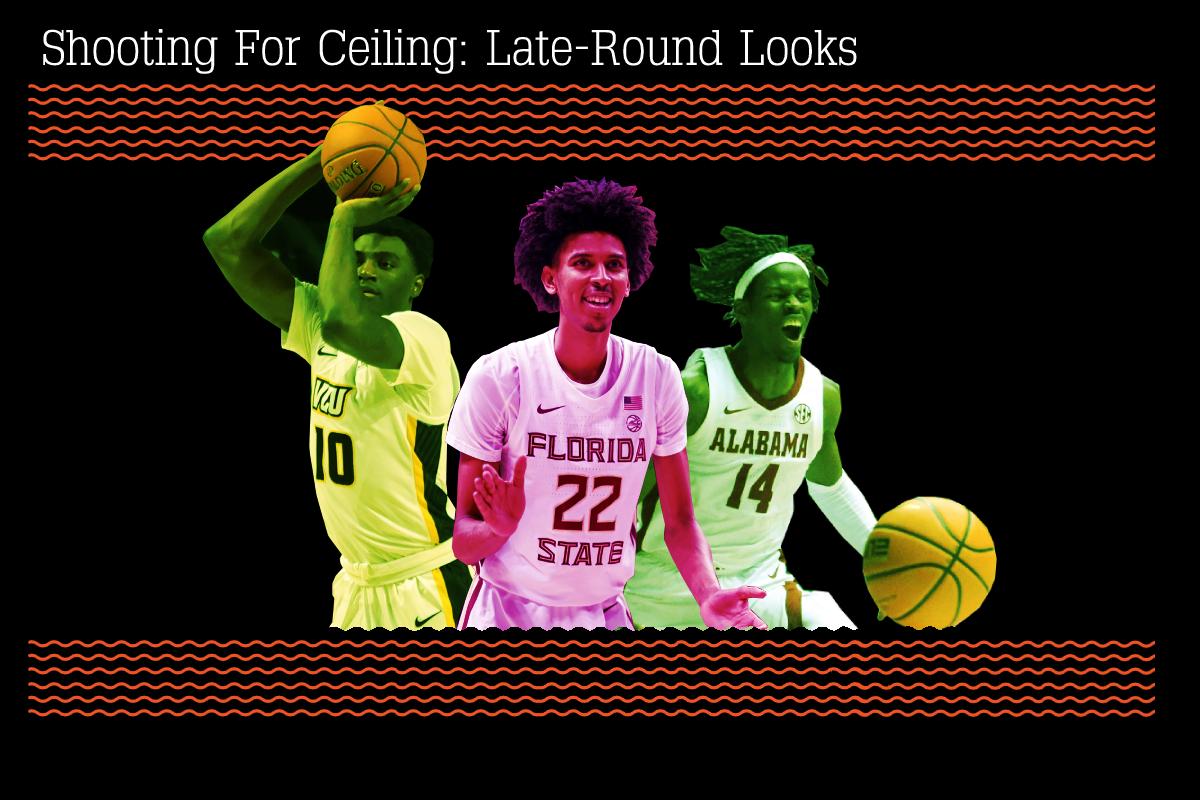
Shooting for Ceiling: Late-Round Looks
While consensus boards generally sway the majority of at-home big boards – those pieces hardly make a dent in an actual draft war room. With teams allocating high sums of time on lottery and undrafted talent alike, there are always players who fly up boards in both rounds.
As aforementioned, the Thunder split the bill in the 2020 NBA Draft selecting a consensus first-rounder in Theo Maledon and then moving up for Vit Krejci, who was not projected to go in the 30s.
Because of these draft-day tendencies and the Thunder’s blueprint allowing for high-risk swings, the 34th pick may read a surprising name completely off the radar for the selection.
Here are a couple of high-upside players not mocked in the 30s but could sneak into Bricktown radars.
John Butler, Wing, Florida State
Marquee Stats: 5.9 points, 3.1 rebounds, 39.3% 3PT
Butler is a special talent based on his measurables. He’s a 7-foot-1, 190-pound forward with a 7-foot-3 wingspan. Needless to say, he’s not your typical player at the two.
Offensively, Butler found himself most comfortable tapped to a corner operating off-the-catch. From distance, he finished the year 33-of-84 (39.3%) while shooting just 82 two-pointers on the season. Butler did show some glimpses and a playmaker, making the extra pass at the perimeter and dropping the ball into the post. However, his slender frame limited him as a slasher, making his inside game obsolete unless off of cuts or lobs.
Defensively, Butler has mobility uncommon for a seven-footer. Butler excelled in the agility tests at the NBA Combine, ranking in the 64th percentile, and 67th percentile in lane agility and the shuttle run tests, respectively. He does a good job as a weak-side shot-blocker to swat shots, but his overall speed also allowed him to get closeout rejections at the perimeter.
The Fit:
Sam Presti has had an infatuation with selecting slender, seven-foot sharpshooters in the past. Two drafts ago, he shipped out big-time assets to accrue Aleksej Pokusevski. This go around, they may very well select Chet Holmgren to be their future center. While it’s hard to envision the Thunder playing these three together on the floor, Butler is a solid piece to develop in the G-League ranks. If the Thunder are set on their roster, exhausting this pick on Butler would actually make an intriguing development for their second two-way contract as his potential is much higher than who's expected to be remaining.
Vince Williams Jr., Wing, VCU
Marquee Stats: 14.1 points, 6.0 rebounds, 1.6 steals
A two-time Atlantic-10 All-Conference nominee, Williams is one of the more decorated second-round picks as a 3-and-D candidate.
Williams has greatly improved on the offensive front. As an underclassman, Williams struggled to get much going on the offensive end, shooting well in the 20s from distance. For the past two seasons, he’s been one of the Rams’ top three-point pieces. This season he posted a 38.7-clip from deep on 5.6 tries per game. These makes came off his fluid left-handed jumper off-the-catch and coming off screens. Even on the interior, he’s polished as a prospect as he’s able to absorb hits finishing around the cup.
Defensively, Williams carries a lot of tools to be successful at the next level. He has incredible length, possessing a wingspan (7’0”) seven inches greater than his height (6’5”). Due to this, he’s able to get involved against 2-4s for steals and blocks alike. In terms of mobility, Williams is not the fastest man on the floor. But his disciplined footwork and sneaky athletic ability allow him to take defenders at the perimeter and add suitable rim protection on close-outs and chasedowns.
The Fit:
Despite four years of college, Vince Williams clocks in at 21 years old. He’s a well-oiled machine as an off-ball threat and has shown flashes of scoring on the deck, too. He is a well-equipped defender with his size and mobility, making him all the marking of a high-level role player for the Thunder.
Keon Ellis, Guard, Alabama
Marquee Stats: 12.1 points, 6.1 rebounds, 1.8 assists
Keon Ellis has been one of the hottest second-round names in the pre-draft process, virtually working out for every team slated in the back-end of the draft. For the Thunder’s interest – they’ve worked him out twice.
On the offensive front, Ellis adds an alluring palate from all areas of the court. Ellis shot at a 40-percent three-point clip in JUCO and shot 36.6% this season at Alabama. On these attempts (5.5 3PA), he became a key piece to lodge in the corner for catch-and-shoot attempts out of the halfcourt. Ellis’ three-point play expanded as well. He showed success coming off stagger screens to launch threes and did a solid job catching and setting his feet for shot attempts. Inside, he’s shown some prowess slashing off hard closeouts and absorbing contact in the lane.
Defensively, Ellis slips into the mold of a trusty backcourt defender. Ellis was one of the top performers in lateral combine drills, backing Ellis’ claim as a good perimeter defender who can keep guards from slashing and navigating around high-ball screens. He uses his 6-foot-9 wingspan to help on closeouts and late-clock situations for contests while also having some quick reflexes to strip the ball loose. He’s a good one-on-one defender in the halfcourt.
If undrafted, Ellis is a slam dunk pick for teams looking to add a two-way piece. The one caveat would be the Thunder’s current backcourt logjam and prospective teams looking to add the 22-year-old. However, you can see the blueprint of adding him on.
Dominic Barlow, Forward, Overtime Elite
Marquee Stats: 14.6 points, 5.0 rebounds, 1.6 assists
Offensively, Barlow carries an attractive frame and archetype to nurture at the next level. At 6-foot-9, 215 pounds, he fits the bill to operate at the four. His greatest strength comes in attacking the basket, as his acceleration and vertical ability make him a key cog in the fastbreak and as a rim runner. Barlow showed flashes of rolling off of screens, but that will be a key growth point moving forward. As a shooter, he seldom shot threes, placing a 30.4% clip on 2.3 attempts per game. However, he did a great job forcing whistles (3.9 FGA) to clock a 76.9% recording at the stripe.
Defensively, Barlow showed flashes of defensive versatility that franchises crave. With OTE, he averaged 1.1 steals and 1.3 blocks per game, showing activity in the passing lanes and right around the rack. The forward’s 7-foot-3 wingspan elevates his defensive floor as with good lateral quickness, there’s room for him to be a multi-positional defender. He has been an inconsistent perimeter to this point, though. He did carry some woes with fouls, averaging 2.3 per contest, but this was not egregious. The mold is there for Barlow on this side of the floor.
The Fit:
Dominic Barlow is an intriguing swing for the fences slated to go late, but it's now unlikely for a team to be very fond of his game. He has the explosiveness and frame attractive for the league and has shown globs of potential virtually everywhere. He needs nurturing in the G League, but he could turn himself into a valuable energy player on both ends.
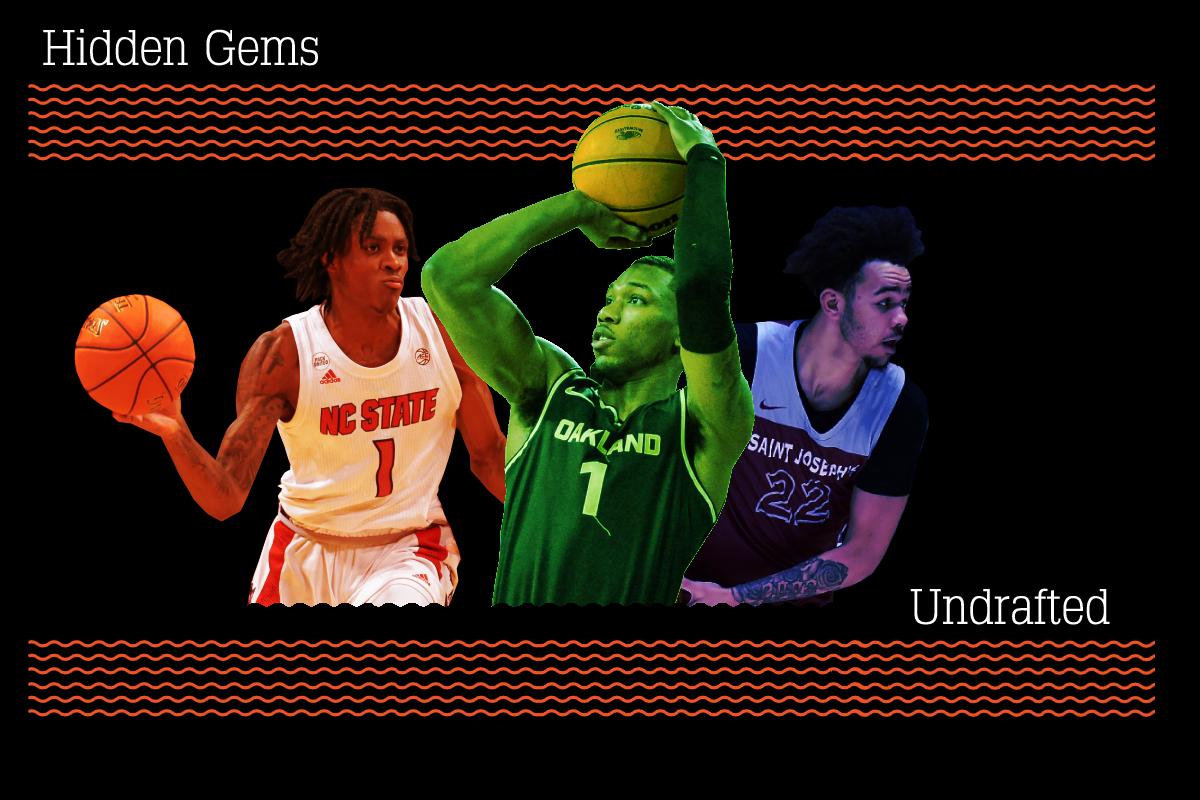
Hidden Gems: Undrafted Prospects
Barring a trade, the Oklahoma City Thunder’s night wraps up after the No. 34 pick. However, recent draft days would tell you that it’s far from over.
Last season, the Thunder acquired a future first-round pick post-draft in taking on veteran Derrick Favors. In the 2020 NBA Draft, the Thunder were quick to the punch on acquiring center Omer Yurtseven. Three drafts back, Oklahoma City added a premier piece in Lu Dort off the undrafted pool.
While the Thunder’s loaded roster may deter agents from sending their prospect to Bricktown – their development program is a clear winner among franchises around the league.
Here are some prospects to monitor in the undrafted conversation:
Jamal Cain, Forward, Oakland
Marquee Stats: 19.9 points, 10.2 rebounds, 1.8 steals
While most consensus big boards exclude Jamal Cain from even scathing a top 100 position on big boards – his offensive explosiveness makes him a prospect undoubtedly on NBA radars.
Cain, age 23, broke out in a post-grad year with Oakland this season, blossoming from a sturdy starter to the Horizon League Player of the Year. His uber-athleticism makes him a dominant threat as a backdoor cutter, alley-oop receiver, transition piece, and roll man off a screen.
At 6-foot-7, Cain also holds a lightning-quick release which makes him very intriguing if he becomes consistent in this area. With the Golden Grizzlies, he revealed a solid mid-range turnaround to tag with his jumper.
Defensively, Cain also shows some light as a ball hawk, claiming 1.8 steals under Greg Kampf’s zone. He’s a small forward, however, his nice lateral quickness and springy aggression on boards make him a player who can be placed anywhere in stints.
Cain needs to shore up in shooting consistency and overall tunnel vision. However, if he’s able to address these key factors – he has all the key makings of an undrafted steal who’d thrive in a win-now system.
For the Thunder, Jamal Cain may not be the best fit due to his size. But, he should add a clear spark to prospective teams looking to amp up the offense. At his base level, Cain will be a monster at the G League level. And, if he works on some kinks – there’s a real chance he’s on a two-way deal to close the season.
Jordan Hall, Forward, St. Johns
Marquee Stats: 14.1 points, 5.8 assists, 1.2 steals
Jordan Hall is a player the Oklahoma City Thunder showed interest in last season, and if he slides out of the draft conversation – he could get a call from Presti.
Hall, age 20, is a 6-foot-8 jumbo guard who thrives out of a pick-and-roll setting. Hall can dish the ball with either hand, is comfortable kicking out of slashes, and uses his height to pass over defenders. He’s shown upside as a shooter, particularly in the corners.
Defensively, Hall has struggled as a one-on-one defender, oftentimes crossing feet when someone makes a hard drive to the basket. He also has issues changing pace on defense as he plants his feet way too often, resulting in giving his opponent space.
Offensively, Hall is a slam dunk piece for the Thunder, especially as an undrafted piece. His on-ball skills are at an NBA level. However, he needs time to develop as a defender if he wants to carve a role.
Makur Maker, Center, Sydney Kings
Marquee Stats: 7.8 points, 6.0 rebounds, 76.9 FT%
Makur Maker, who worked out with the Thunder pre-draft, is a 6-foot-11 big man fresh of an NBL Next Stars deal with the NBL champion Sydney Kings.
Maker, cousins of Thon Maker and Matur Maker, was a key role player on the Kings’ roster this season, using his big-time frame to create offense inside. The former five-star is nimble for 232 pounds, doing a good job running in transition while also covering ground on rebound attempts and closeouts.
There are some questions on how Maker would transition to the NBA, but the talent is there. He’s very similar to his cousins in the fact he’s a solid handler at his position, has flashed perimeter potential (36.1% 3PT), and has a unique frame.
At age 22, Maker may be a potential Exhibit-10 signee who may work his way up in the ranks. He’s still raw as a prospect, but could become an intriguing piece with some time in the G League.
Dereon Sebron, Guard, North Carolina State
Marquee Stats: 17.3 points, 8.2 rebounds, 3.2 assists
Sebron, who worked out for the Thunder pre-draft, is a 6-foot-7 combo guard who has shown both playmaking ability and on-ball slashing at a high level.
Sebron is a rugged slasher. At 180 pounds, he’s a lethal attacker who’s able to make mid-air adjustments for buckets while keeping the whistle wet. He averaged 6.3 free throw attempts per game this season, and all credit must be handed to his scrappy play on the interior. As a passer, he’s better than the numbers indicate as well as he’s a solid passer on drives.
His overall motor makes him a scary player as a rebounder, soaring up for rebounds like he was a center at times. Sebron averaged 1.4 steals per game this year, utilizing his quickness to sneak into plays and go into transition.
Sebron needs to ramp up as a shooter, shooting a bare 25.4% on threes collegiately. However, his overall toughness on both ends should give him some chatter in the undrafted pool.
Kenny Lofton Jr., Big, Louisiana Tech
Marquee Stats: 16.5 points, 10.5 rebounds
There were unconfirmed reports that Kenny Lofton Jr. worked out with the Oklahoma City Thunder earlier in the draft process. However, those cannot be confirmed at this time.
What was a definite is that Lofton Jr. was the clear-cut best performer at the NBA Combine this year. Starting out as a G League Camp invite, Lofton Jr. averaged 13.0 points and 7.5 rebounds in G League play to earn an NBA Combine nod. In the actual combine, he starred again, placing 13 points, three rebounds, and three steals in his lone appearance.
Lofton Jr. is notably bulky at 6-foot-7, 280 pounds, but he does have elite footwork that allowed him to dominate in the painted area. While there are few players with Lofton’s size in NBA roles, his prestigious back-to-basket play makes him worth a look for prospective teams.
At a bare minimum, Lofton Jr. will have the majority of teams clamoring for an Exhibit-10 contract, and at 19, his potential may warrant a two-way nod.
David McCormack, Forward, Kansas
Marquee Stats: 10.6 points, 7.0 rebounds, 0.8 blocks
As a two-time All-Big 12 honoree, McCormack enters this draft class as a 22-year-old graduate from Kansas.
At 6-foot-10, McCormack has NBA-ready size to play the four position. Offensively, virtually all of his production came inside as he shot five threes his entire career. Instead, he thrived rolling to the basket or going up for second chance tries. He’s a refined screen setter whose bounce allowed him to corral 3.1 offensive boards a game, making him a valuable rebounder. McCormack shot a career 76.0% at the stripe, meaning a mid-range game could be in sight.
Defensively, his combination of athleticism and frame continue to make him a viable interior threat. He was far too aggressive in contests, oftentimes keeping him in foul trouble early. But, he does have to check the boxes as a solid rebounder here.
Overall, McCormack is a type of prospect likely outside of the Thunder’s radar. But, he’d be a great look for the Oklahoma City Blue. With previous inside-out fours such as Rashawn Thomas and Tyler Cook thriving with the Blue – McCormack would provide a big-time enforcer to help their current prospects. Plus, with D.J. Wilson likely gone, he’d clear a major void.
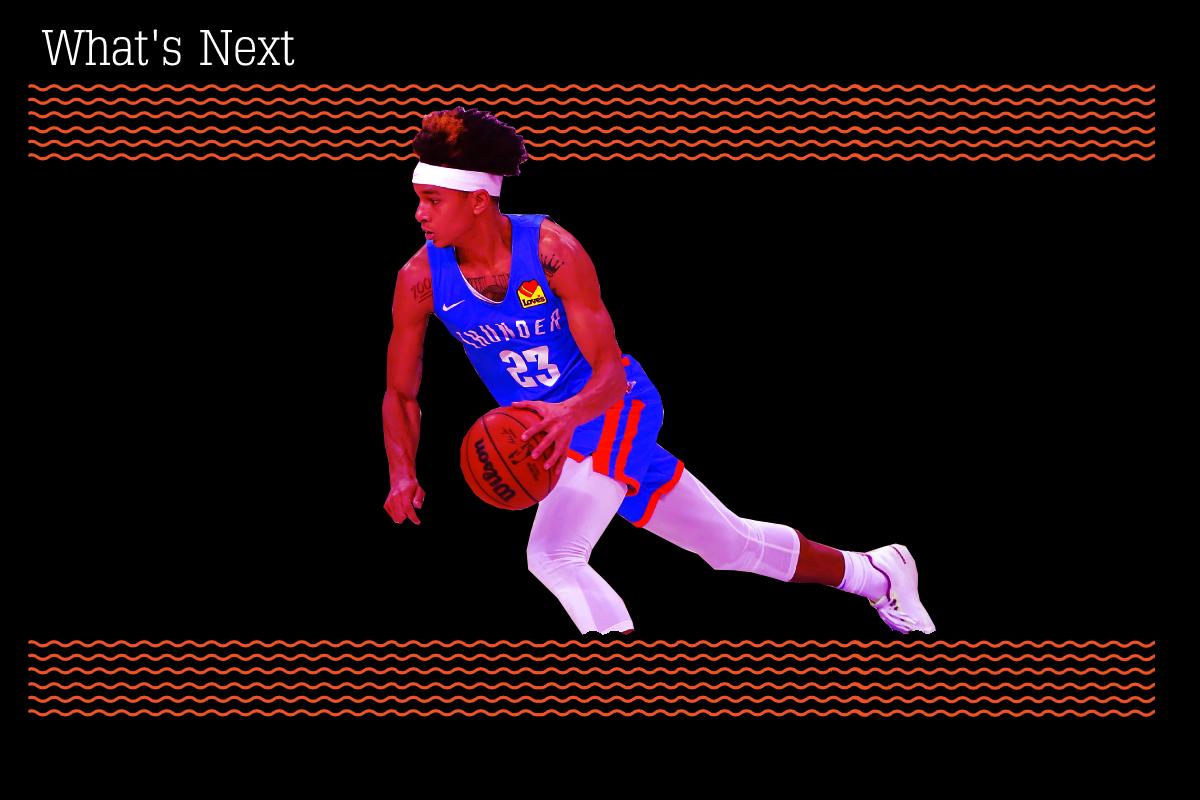
What’s Next:
Following the Thunder’s draft-day haul, all eyes will be on how the franchise goes about Lu Dort’s team option. As noted earlier, Dort has a fourth-year option attached to his contract. If the Thunder exercise this option, he’ll be due $1.9 million next season, which would make him one of the top budget players in the league. The downside to this is that he’d be an unrestricted free agent in the 2023 offseason.
If the Thunder declines his option by June 29, he’d become a restricted free agent this offseason. Though the short-term downside is apparent in cap space, it’ll allow the franchise to retain him long-term via matching the top offer.
After this free agency call, Oklahoma City will shift its attention to next month’s Summer League.
Over the course of July 5-17, the Thunder will embark upon eight Summer League games, split between the Utah and Las Vegas circuits.
For the first time in franchise history, the Thunder will be in attendance for the Salt Lake City Summer League. In this three-day event, spanning from July 5-7, the Utah Jazz, Philadelphia 76ers, Memphis Grizzlies, and Thunder will compete in a three-game, round-robin format at Vivint Smart Arena.
Following the three-day venture, they will head to Las Vegas Summer League from July 7-17 to place five additional games.
For the Thunder, their ESPN2 appearance on July 9 marks the end of a 163-day cold spell on national television. The organization’s last nationally-televised contest came on December 19, 2021, from the franchise’s G League affiliate Oklahoma City Blue. In this meeting, the Blue faced the Rio Grande Valley Vipers in the first round of Winter Showcase Cup action.
In the case of the Oklahoma City Thunder, their date with the Magic snaps a 329-day drought as their last national-televised contest came against the Indiana Pacers on August 14, 2021, in the 2021 Summer League.
There are lots of moving parts in assembling Summer League rosters, but the Thunder have a solid base to build off of. As noted by Sam Presti in his exit interview, he plans on rolling out Josh Giddey and Aleksej Pokusevski, among others, for Salt Lake City. Alongside these two, core pieces in Tre Mann, Jeremiah Robinson-Earl, Aaron Wiggins, Theo Maledon, Lindy Waters III, and more could also make some appearances.
As the biggest arrivals of them all, the Thunder’s three selections are also likely to play in the Summer League outlet.
On the Oklahoma City Blue front, it’s hard to picture who will return in a Thunder jersey. Last season, the Thunder’s lone Blue members to return were Rob Edwards, Jaylen Hoard, and Ryan Woolridge, who signed an overseas deal prior. While members such as Zavier Simpson and Melvin Frazier Jr. returned post-Summer League, it’s more advantageous to play in a Summer League system that gives you the best shot of making the training camp.
Want to join the discussion? Like SI Thunder on Facebook and follow us on Twitter to stay up to date on all the latest Thunder news. You can also meet the team behind the coverage.
